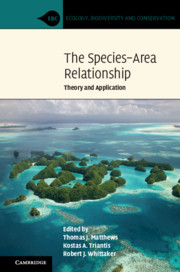Book contents
- The Species–Area Relationship
- Ecology, Biodiversity and Conservation
- The Species–Area Relationship
- Copyright page
- Contents
- Contributors
- Foreword
- Preface
- Part I Introduction and History
- Part II Diversity–Area Relationships: The Different Types and Underlying Factors
- Part III Theoretical Advances in Species–Area Relationship Research
- 7 Mathematical Expressions for the Species–Area Relationship and the Assumptions behind the Models
- 8 Biodiversity Scaling on a Continuous Plane: Geometric Underpinnings of the Nested Species–Area Relationship
- 9 Species Accumulation Curves and Extreme Value Theory
- 10 The Species–Area Relationship: Idiosyncratic or Produced by ‘Laws Acting around Us’?
- 11 The Species–Area Relationships of Ecological Neutral Theory
- 12 On the Interface of Food Webs and Spatial Ecology: The Trophic Dimension of Species–Area Relationships
- Part IV The Species–Area Relationship in Applied Ecology
- Part V Future Directions in Species–Area Relationship Research
- Index
- References
7 - Mathematical Expressions for the Species–Area Relationship and the Assumptions behind the Models
from Part III - Theoretical Advances in Species–Area Relationship Research
Published online by Cambridge University Press: 11 March 2021
- The Species–Area Relationship
- Ecology, Biodiversity and Conservation
- The Species–Area Relationship
- Copyright page
- Contents
- Contributors
- Foreword
- Preface
- Part I Introduction and History
- Part II Diversity–Area Relationships: The Different Types and Underlying Factors
- Part III Theoretical Advances in Species–Area Relationship Research
- 7 Mathematical Expressions for the Species–Area Relationship and the Assumptions behind the Models
- 8 Biodiversity Scaling on a Continuous Plane: Geometric Underpinnings of the Nested Species–Area Relationship
- 9 Species Accumulation Curves and Extreme Value Theory
- 10 The Species–Area Relationship: Idiosyncratic or Produced by ‘Laws Acting around Us’?
- 11 The Species–Area Relationships of Ecological Neutral Theory
- 12 On the Interface of Food Webs and Spatial Ecology: The Trophic Dimension of Species–Area Relationships
- Part IV The Species–Area Relationship in Applied Ecology
- Part V Future Directions in Species–Area Relationship Research
- Index
- References
Summary
Although the species–area relationship (SAR) is commonly presumed to be either a power law or to follow the logarithmic relationship, a large number of other mathematical expressions have been proposed to describe the relationship. These models can be divided into four general categories, distinguishing between asymptotic and non-asymptotic, and between convex upward and sigmoid models (in arithmetic space). The choice of regression model should not be determined by best fit alone; rather, the choice should relate to the purpose of fitting mathematical models to SAR data: either descriptive, explicative or predictive. Therefore, we should choose models that are likely to result from expected ecological patterns. We argue that neither (accumulative) sample-area SARs (saSARs) nor island SARs (ISARs) have upper asymptotes and ISARs may be sigmoid if the smallest islands (finest scales) are included. Amongst the 30 different models we review here, few are non-asymptotic. Both the power model and logarithmic model return convex non-asymptotic curves, whereas the second persistence (P2) model and the quadratic logarithmic model consistently return sigmoid curves without asymptotes. We add the Tjørve-hybrid to this shortlist, as it can be useful when neither the power nor the logarithmic model provides a good fit to saSAR data.
Keywords
- Type
- Chapter
- Information
- The Species–Area RelationshipTheory and Application, pp. 157 - 184Publisher: Cambridge University PressPrint publication year: 2021
References
- 2
- Cited by

